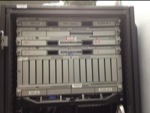Over the years of working with automation, one of the tasks I’ve always enjoyed was Caller ID. Knowing who was calling before you picked up, a joy of modern living. Having a computer broadcast Caller Id over the network using Growl, logging the call to display on a web page. Having it run a script depending on who is calling, truly geeky?
One of the fun things I did with Caller ID was deciding what do when someone entered or exited our community through our gates. The association has two phone lines, one for incoming visitor and one for exiting. What the computer said and did was determined by the number calling in.
Doing this task was a Mac Mini G4 and a OVOLab Usb Adapter running the PHLINK software and a bit of Applescript. Not difficult at all pretty much plug and play.
Twice over the span of 10 years, either the phone company or the power company has blown at least two adapters. The last time was about a month ago, not a cloud in the sky, and the power goes out. When it comes back on, my lovely adapter is once again blown.
Now the fun part, trying to find a replacement. There were two companies that made similar devices, OVOLabs and Parliant’s Phone Valet. Both are now off the market. … WHAT!?
OK.. So here are my problems.I have a few Mac Mini G4’s for automation and a couple of Intel Mac Minis which I use as servers. The servers are taxed to the max. The Mac Mini G4 has a built in modem which does NOT support Caller ID. After a bit of research I found out that the Apple’s USB Modem Adapter does support Caller ID. (Oh and I found out these do not work on the Intel iMacs! ).. Quick trip to eBay and $22!
Next problem, how to enable and use the Caller ID feature? First what program to use. The program that came up most on web searches was CIDTrackerX, which to my surprise I had purchased a license for back in 2003. And the second was MacCallerID. MacCallerID is a dead end, the web site is down, a very old mac.com web site. With no way to contact the author. However, CIDTracker (or CIDTrackerX), I emailed the author asking if his software had any unpublished updates and he replied. (He’d contact me in a few days). – While waiting I continued my quest.
So I continued to test CIDTrackerX. One of the things you need is the command to enable Caller ID on your modem. Back in the 80’s I lived Hayes AT commands, Hayes was king. I was surprised that the command set was still being developed and used, with what seemed like hundreds of new commands. With hundreds of new variations. Finding the one to enable CID on the Apple USB Modem took a little searching.
AT+VCID=1 to enable
AT+VCID=0 to disable
With those command in hand I returned to CDTrackerX and entered those into the proper boxes. Nothing! ARG. Hope Mr. Dean Davis of AfterTen Software gets back to me soon!
In the mean time I tested the modem a bit more using CoolTerm by Roger Meier at http://freeware.the-meiers.org . A wonderful free program I have used for years. Connect to modem, issue the enable command and call the phone line connected to modem. JOY, Caller ID info.
As it stands now I have two choices, wait for Mr. Davis to email back, or start working on my own software to deal with CID…
Know what I am doing this weekend!



